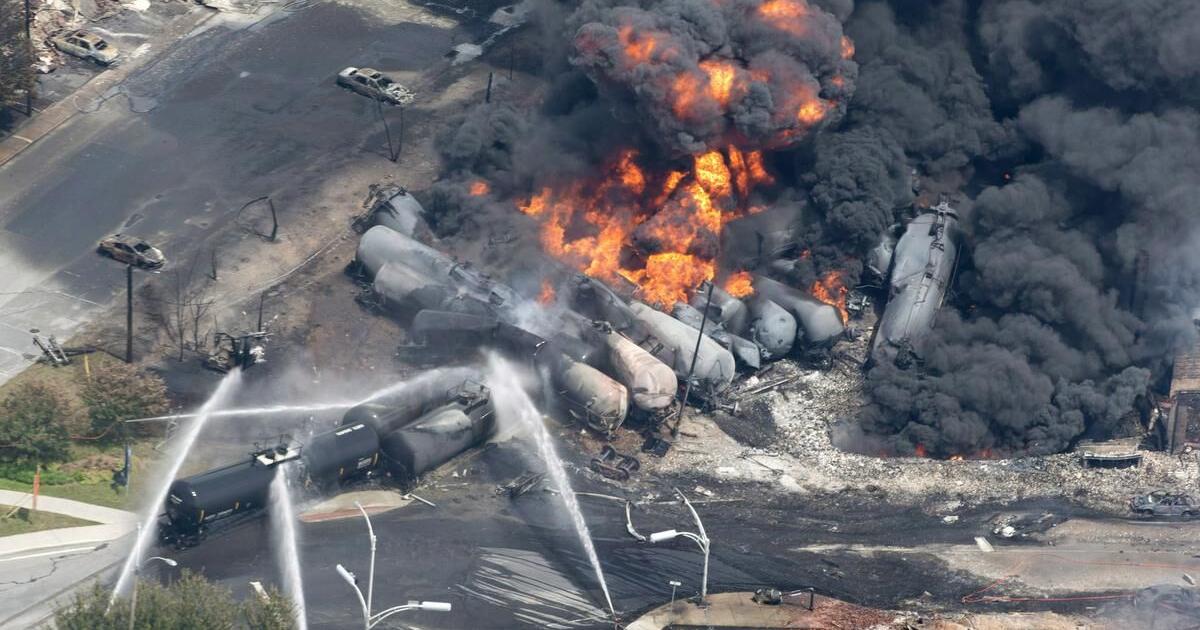Hinton train collision
From Wikipedia, the free encyclopedia
[...]
The Hinton train collision was a rail transport accident that occurred in Canada on 8 February 1986. Twenty-three people were killed in a collision between a Canadian National Railway freight train and a Via Rail passenger train called the Super Continental, including the engine crews of both trains. It was the deadliest rail disaster in Canada at this time, since the Dugald accident of 1947 which had thirty-one fatalities, and was not surpassed until the Lac-Mégantic rail disaster in 2013, which resulted in 47 deaths.
After 56 days of testimony at a public inquiry, a commission concluded that the collision was caused by the freight crew failing to stop their train because of incapacitation or other unknown factors. The report also highlighted serious flaws in the culture and safety practices at Canadian National Railway.
[...]
Investigation
The Canadian government set up a Commission of Inquiry to investigate the crash. It was led by Justice René P. Foisy, Court of Queen's Bench of Alberta. The inquiry lasted 56 days of public hearings and received evidence from 150 parties. The Foisy Commission published its full report on 22 January 1987.
The inquiry concluded that no one individual was to blame, instead it condemned what Foisy described as a "railroader culture" that prized loyalty and productivity at the expense of safety. As an example of lax attitudes to safety, Foisy noted that engineering crews that took over trains at Edson did so "on the fly". While the locomotive was moving slowly through the yard, the new crew would jump on and the previous crew would jump off. While this method saved time and fuel, it was a flagrant violation of safety regulations which required stationary brake tests after a crew change. Management claimed to be unaware of this practice, even though it was quite common. In regards to engineer John Hudson, the Foisy Commission concluded it was a possibility that the collision happened because he had either fallen asleep at the controls or had suffered a heart attack or stroke due his extremely poor health.
The report highlighted that there was no evidence that either train made any attempt to brake prior to the collision. Analysis of the line showed both trains would have only been visible to each other for the final 19 seconds before the collision. No conclusive reason could be found for the failure of the passenger train crew to react, neither was there any evidence that the Super Continental crew had made any errors before the accident. No evidence could be found to explain why the freight train failed to stop at the absolute signal at the Dalehurst control point. After a wrong-side signal problem was eliminated, human error was considered the only possible cause. Tests on the crews' remains ruled out drugs or alcohol as a cause, though it was revealed that the engineer of the freight train, Jack Hudson, was an alcoholic and heavy smoker who suffered from pancreatitis and type 2 diabetes, thus placing him at risk for a heart attack or stroke.[8] The commission further criticized CN's ineffective monitoring of Hudson's health condition:
The serious nature of Hudson's medical condition...raises a strong possibility that it was a factor contributing to the collision of February 8...The Commission therefore concludes that engineer Hudson's medical condition possibly contributed to his failure to control Train 413. The Commission also concludes that there are serious deficiencies in the manner in which CN monitored and reacted to that condition. The Commission finds that both the policies and procedures that permitted a man in Hudson's medical state to be responsible for the operation of a freight train on the CN main line to be unacceptable.[8]
Another frequently ignored safety regulation mentioned in the report was the "deadman's pedal", which a locomotive engineer had to keep depressed for the train to remain underway. Were he to fall asleep or pass out, his foot would slip from the pedal, triggering an alarm and engaging the train's brakes automatically a few seconds later. However, many engineers found this tiresome and bypassed the pedal by placing a heavy weight (often a worn out brake shoe) on it. It was uncertain whether the pedal had been bypassed in this case because the lead locomotive of the train had been destroyed. A more advanced safety device was available, the reset safety control (RSC), which required crew members to take an action such as pushing a button at regular intervals, or else automatic braking would occur, but neither lead locomotive was equipped with this safety feature. While the second locomotive in the freight train was equipped with RSC, it was not assigned as the lead locomotive because it lacked a "comfort cab". Management and union practice was to place more comfortable locomotives at the front of trains, even at the expense of safety.
The report also noted that although the front-end and rear-end crews should have been in regular communication, that did not appear to be the case in this accident. As the freight train reached Hargwen, Engineer Hudson radioed back to Conductor Smith that the signals were green, a communication that was heard by a following freight. As it ran towards Dalehurst there was no evidence of further communication. The conductor is in charge of the train, so if Smith felt that the train was out of control or there were serious problems, he should have activated the emergency brake in the caboose to stop the train. However, Smith, who appeared to be nervous while testifying, said that he did not feel that the freight was ever out of control, misjudging its speed. He also testified that he attempted to radio Hudson on two radios and several channels, but neither seemed to be working, even though immediately after the crash Smith was able to contact the dispatcher by radio. Despite Smith's testimony, he apparently decided not to stop the train.






/cloudfront-us-east-1.images.arcpublishing.com/tgam/3QWW4C3K5RNIFCDNEBW35CAJHU.jpg)
